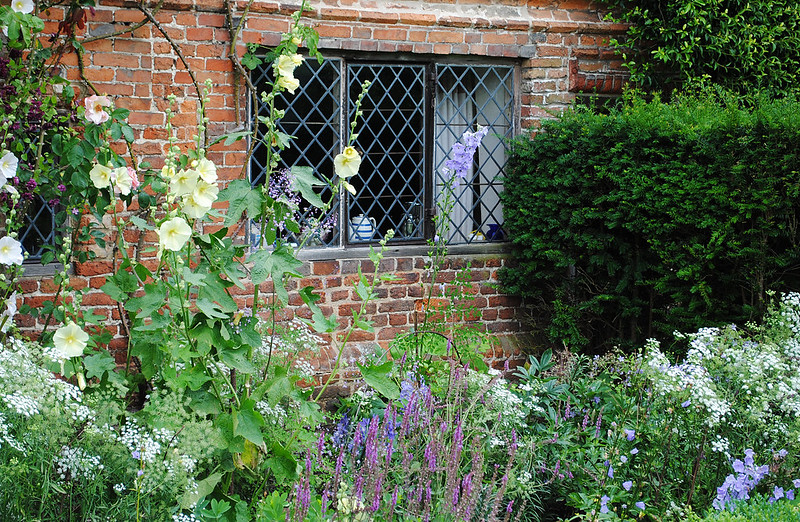Cottage gardens are not complete without hollyhocks, a beloved, traditional biennial. Hollyhocks bloom from mid-summer to the first frost of fall and bring a strong vertical accent to any garden design. Plant hollyhocks at the back of a garden bed to screen a shed or other unsightly fence, or use them to attract pollinators to a kitchen garden.

Photo by Mark Wordy, unmodified, Flickr, copyright CC BY 2.0 DEED
Growing hollyhocks is easy no matter if you transplant small starts or plant seeds directly in the ground. Because these are biennial plants and not true perennials, they die back after they flower in the second year. Regular deadheading to prevent seeding will prolong their lifespan by a year or two, but allowing them to self-seed will ensure their presence from year to year.
Hollyhocks grow best in full sun, with at least 6 hours of direct light a day, and in well-draining soil. Hollyhocks are highly susceptible to powdery mildew and rust diseases, particularly late in the growing season. Providing ample sun and room to grow will reduce the chances of infection.
Shrubs To Plant With Hollyhocks
Hollyhocks have a romantic and relaxed look that works well in informal garden settings. Placing them at the back of a mixed shrub and perennial border is a great way to anchor a design and take advantage of shrubs that may be finished blooming early in the summer. Deciduous shrubs with deep green leaves, such as lilacs, spirea, viburnum, forsythia, and star magnolias, will provide a clean backdrop for the soft colors of hollyhocks.
Perennials To Plant With Hollyhocks
Virtually any sun-loving perennial will make a great companion for hollyhocks. Cottage garden favorites, such as foxglove, mullein, lupines, and blazing star echo the tall shape of hollyhock flowers and come in many contrasting or complementary colors. Lower-growing perennials like perennial baby’s breath, bee balm, globe thistle, black-eyed Susan, and coneflowers can be planted at the base of hollyhocks to help disguise their bare stems that develop in the summer.
Allow plenty of room between plants to keep air circulating around the plants in the border. Plant these combinations in full sun to reduce mildew and rust, which can be very contagious and not always plant specific.

Annuals To Plant With Hollyhocks
Many annuals look great in garden beds with hollyhocks. Taller annuals can be planted in between hollyhocks to add contrasting color and leaf textures. Some of our favorites include cosmos, sunflowers, zinnias, and single-bloom dahlias, which can be left to self-seed throughout the summer or replanted each year to change up color combinations or design ideas. For the front of the bed, select low-growing marigolds, calendula, four o’clocks, and nasturtiums. These annuals provide long-lasting color and freely self-seed. Any unwanted seedlings can be pulled up or relocated early in the spring.
Best Companion Plants For Hollyhocks in Containers
Dwarf and miniature types of hollyhocks have been bred to stay compact and make nice thriller elements in mixed seasonal planters. For fillers, shasta daisy and coreopsis will look fresh and perky alongside spiller elements such as calibrachoa and sweet alyssum.
Select containers with drainage holes and fill them with a high-quality potting mix. Fertilize container plantings monthly with a diluted liquid formulation intended for blooming plants. Old-fashioned varieties of hollyhocks can reach heights of 4-6 feet or more and may require support from a bamboo cane to protect the stems from breaking as the season progresses.
Plants Not To Grow With Hollyhocks
Hollyhocks do not tolerate standing water at any time of the year. Avoid planting hollyhocks with bog-type plants like astilbe, flag iris, marsh marigold, and cattails. Also avoid shade-loving plants such as ferns, hostas, brunnera, and hellebores, which require more shade than hollyhocks tolerate.
Best Plants To Grow With Hollyhocks
Hollyhocks grow well with tall plants that enjoy sunny locations and well-drained, fertile soil. Plants with a casual, rustic feel, such as mullein, cosmos, black-eyed Susan, and baby’s breath look best with hollyhocks and will self-seed for easy maintenance. Use these proven favorites to add color and charm to any cottage garden.
 |
Author Robbin Small - Published 10-19-2023 |
